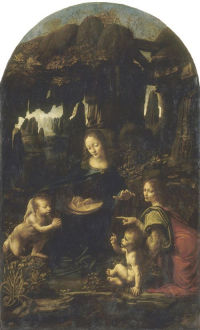
- Enlarge
- Zoom & explore
- Photo RMN - © René-Gabriel Ojéda
Virgin of the Rocks 1483-c1490
This painting was commissioned in 1483 by the Milanese Confraternity of the Immaculate Conception for their large sculpted altarpiece in their chapel of San Francesco Grande, Milan. It was one of a series of painted and sculpted components of a large altarpiece, which included two paintings of music-making angels, now in the National Gallery, London, reliefs portraying episodes from the life of Mary, sculptures of prophets and a large wooden sculpture of the Virgin.
According to the documents, Leonardo was assisted by the brothers Evangelista and Giovanni da Predis in the execution of the altarpiece. A protracted and complex dispute ensued in 1483 regarding payment, which was not resolved until 1508 with the placement of a second version of this painting, now in the National Gallery, London, in the altarpiece.
The execution of a second version of the painting implies that during the years following its completion, the Louvre version must have been either taken, given away or sold. It is possible that it was sold to a third party, possibly Ludovico Sforza.
- Medium Oil on wood panel (transferred to canvas in 1806)
- Size 197 x 120 cm
- Location Musée du Louvre

